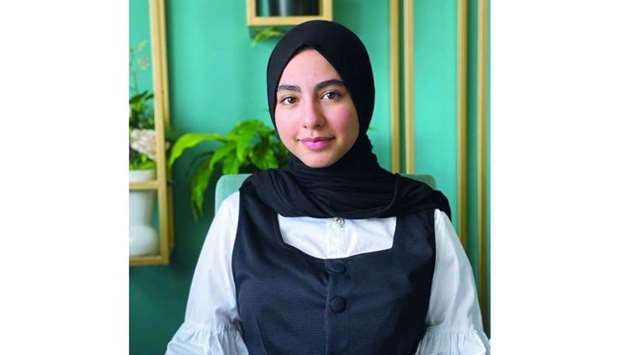Two young change-makers who are getting a taste of technology in a university setting while still at school are determined to follow their dreams after shining in an international competition for aquatic robotics.
Bissan Abdelghany and Mahi Sharma both believe technology is the future. They say that the STEM education they have received as Grade 10 students at Qatar Academy for Science and Technology (QAST) – part of Qatar Foundation’s (QF) Pre-University Education – has helped them to transform ideas into realities, and paved the way for them to become technology innovators rather than consumers.

As they continue their school studies, they have also become members of the robotics team at QF partner university Texas A&M University at Qatar (Tamuq), which has seen them get an early chance to show their talents and represent Qatar on a global stage. It’s the opportunity to attend and participate in training and workshops within the QF ecosystem that both students say has helped them create a vision for their future.
“I became interested in robotics as soon as we started learning about them at QAST,” said Abdelghany. “The school uses visual learning as the primary teaching tool, so we learn based on what we see. And, not only that, but we – as students – also contribute to our own learning by trying to figure out solutions to problems.
“This meant that I had the chance not only to work on robotics using technology, but also to build robots – which involved coding and programming.”
Although her passion was never engineering-based, Sharma now believes that the training and workshops she had access to at QAST changed her perspective, teaching her how to take an idea from the early stage of planning to execution.
“Myself, Bissan and other students were chosen by Dr Mohamed Gharib, a STEM education specialist from Tamuq, to represent Qatar in the International SeaPerch Competition 2021,” she explained. “It is a global challenge for underwater robotics, about how to use resources to develop a ROV – or Remotely Operated Vehicle – for a specific purpose.
“Our team created an ROV that records and monitors underwater pipelines to check for rust and cracks to see if any oil spills could happen pre-emptively.”
Explaining what it took for the Qatar team to win third place in robotics at the competition, where they were up against 800 participants from around the world, Abdelghany said: “The process that led to this achievement was commitment.
“At QAST, there is a subject called innovation, where we come up with new ideas and work on projects. It was this subject that enabled us to participate in and qualify for the SeaPerch challenge; we were then asked by Tamuq to join their robotics team to prepare for the competition – and we went on to win third place.”
The Innovation Centre is a special 2-hour daily class that is unique to QAST’s award-winning authentic problem-based learning model called “CRISP’. It is a cyclical process of Challenge, Research, Investigate, Synthesize and Prototype; which helps boost students’ critical thinking and problem-solving skills by engaging them in real-life scenarios.

Mahi Sharma
As they continue their school studies, they have also become members of the robotics team at QF partner university Texas A&M University at Qatar (Tamuq), which has seen them get an early chance to show their talents and represent Qatar on a global stage. It’s the opportunity to attend and participate in training and workshops within the QF ecosystem that both students say has helped them create a vision for their future.
“I became interested in robotics as soon as we started learning about them at QAST,” said Abdelghany. “The school uses visual learning as the primary teaching tool, so we learn based on what we see. And, not only that, but we – as students – also contribute to our own learning by trying to figure out solutions to problems.
“This meant that I had the chance not only to work on robotics using technology, but also to build robots – which involved coding and programming.”
Although her passion was never engineering-based, Sharma now believes that the training and workshops she had access to at QAST changed her perspective, teaching her how to take an idea from the early stage of planning to execution.
“Myself, Bissan and other students were chosen by Dr Mohamed Gharib, a STEM education specialist from Tamuq, to represent Qatar in the International SeaPerch Competition 2021,” she explained. “It is a global challenge for underwater robotics, about how to use resources to develop a ROV – or Remotely Operated Vehicle – for a specific purpose.
“Our team created an ROV that records and monitors underwater pipelines to check for rust and cracks to see if any oil spills could happen pre-emptively.”
Explaining what it took for the Qatar team to win third place in robotics at the competition, where they were up against 800 participants from around the world, Abdelghany said: “The process that led to this achievement was commitment.
“At QAST, there is a subject called innovation, where we come up with new ideas and work on projects. It was this subject that enabled us to participate in and qualify for the SeaPerch challenge; we were then asked by Tamuq to join their robotics team to prepare for the competition – and we went on to win third place.”
The Innovation Centre is a special 2-hour daily class that is unique to QAST’s award-winning authentic problem-based learning model called “CRISP’. It is a cyclical process of Challenge, Research, Investigate, Synthesize and Prototype; which helps boost students’ critical thinking and problem-solving skills by engaging them in real-life scenarios.

